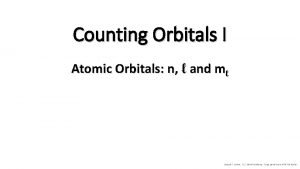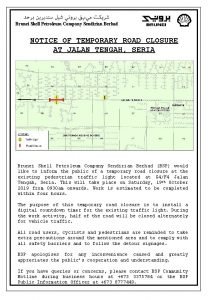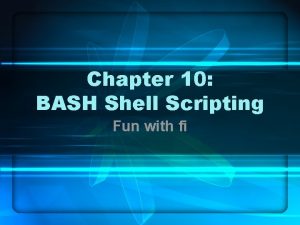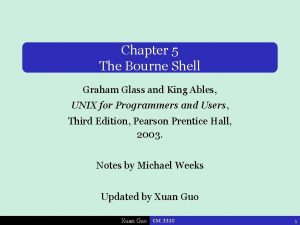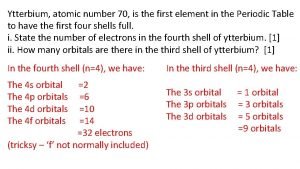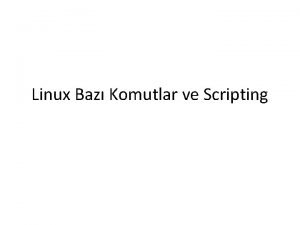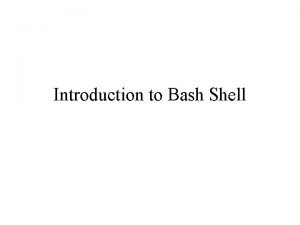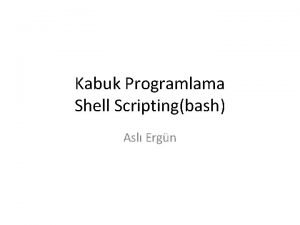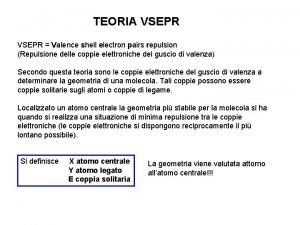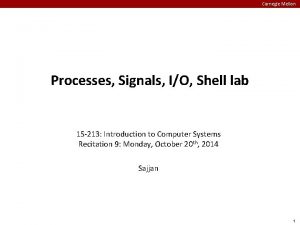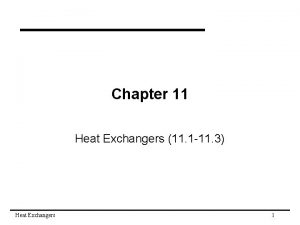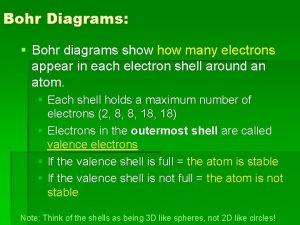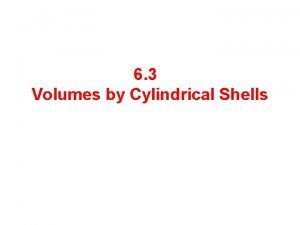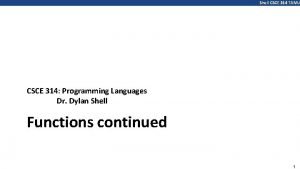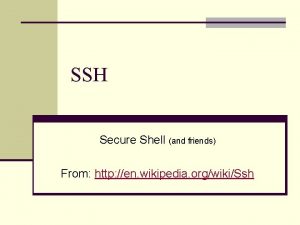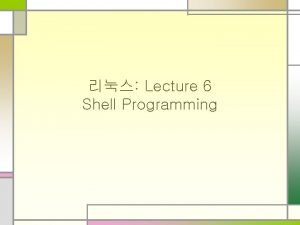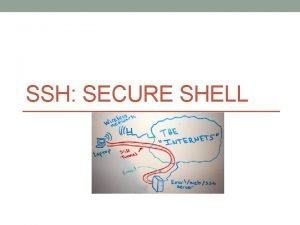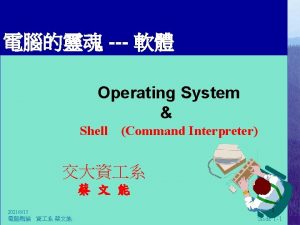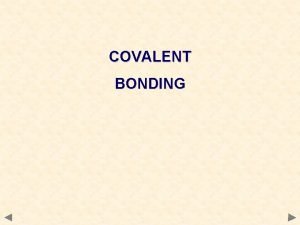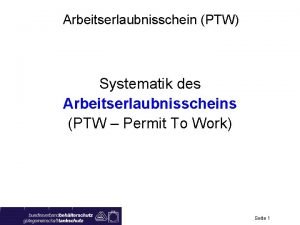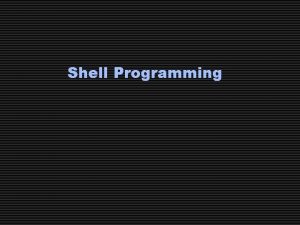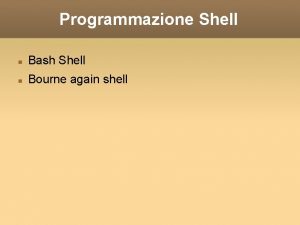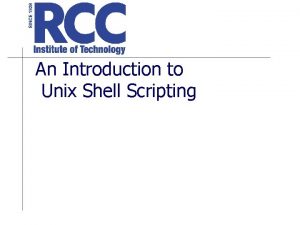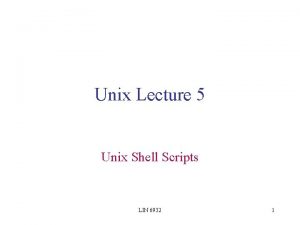UNIX 1 UNIX 2 3 vi 4 Shell





![Command Line 형식 • 형식: $ command [-option] [argument] • 예: $ date Wed Command Line 형식 • 형식: $ command [-option] [argument] • 예: $ date Wed](https://slidetodoc.com/presentation_image_h/f9ddaf8c7479d2db3c43cd029d3f92cd/image-6.jpg)
![Online 매뉴얼 • 형식: man [-X] command X: Manual Page Section number • Section Online 매뉴얼 • 형식: man [-X] command X: Manual Page Section number • Section](https://slidetodoc.com/presentation_image_h/f9ddaf8c7479d2db3c43cd029d3f92cd/image-7.jpg)
















![cat 명령어 • 형식 cat file [file …] • 예 $ cat f 1 cat 명령어 • 형식 cat file [file …] • 예 $ cat f 1](https://slidetodoc.com/presentation_image_h/f9ddaf8c7479d2db3c43cd029d3f92cd/image-24.jpg)

![head, tail 명령어 • 형식 head [-n number ] filename tail -f [-n number head, tail 명령어 • 형식 head [-n number ] filename tail -f [-n number](https://slidetodoc.com/presentation_image_h/f9ddaf8c7479d2db3c43cd029d3f92cd/image-26.jpg)

![mv 명령어 • 형식 mv [-i] file 1 new_file mv [-i] file [file …] mv 명령어 • 형식 mv [-i] file 1 new_file mv [-i] file [file …]](https://slidetodoc.com/presentation_image_h/f9ddaf8c7479d2db3c43cd029d3f92cd/image-28.jpg)
![rm 명령어 • 형식 rm [-if] filename [filename. . ] rm -r [-if] filename rm 명령어 • 형식 rm [-if] filename [filename. . ] rm -r [-if] filename](https://slidetodoc.com/presentation_image_h/f9ddaf8c7479d2db3c43cd029d3f92cd/image-29.jpg)
![diff 명령어 • 형식 diff [-i] file 1 file 2 파일의 내용을 비교함 -i diff 명령어 • 형식 diff [-i] file 1 file 2 파일의 내용을 비교함 -i](https://slidetodoc.com/presentation_image_h/f9ddaf8c7479d2db3c43cd029d3f92cd/image-30.jpg)
![ln 명령어 • 형식 ln file new_file ln file [file …] dest_dir Link to ln 명령어 • 형식 ln file new_file ln file [file …] dest_dir Link to](https://slidetodoc.com/presentation_image_h/f9ddaf8c7479d2db3c43cd029d3f92cd/image-31.jpg)






![chown, chgrp • 형식 chown [-R] owner filename chown [-R] owner: group filename chgrp chown, chgrp • 형식 chown [-R] owner filename chown [-R] owner: group filename chgrp](https://slidetodoc.com/presentation_image_h/f9ddaf8c7479d2db3c43cd029d3f92cd/image-38.jpg)



![rlogin • 형식 rlogin hostname [-l username] hostname 으로 원격접속한다. -l username: 해당 username으로 rlogin • 형식 rlogin hostname [-l username] hostname 으로 원격접속한다. -l username: 해당 username으로](https://slidetodoc.com/presentation_image_h/f9ddaf8c7479d2db3c43cd029d3f92cd/image-42.jpg)
![ftp - file transfer program • 형식 $ ftp [ hostname] (hostname 과의) 파일전송 ftp - file transfer program • 형식 $ ftp [ hostname] (hostname 과의) 파일전송](https://slidetodoc.com/presentation_image_h/f9ddaf8c7479d2db3c43cd029d3f92cd/image-43.jpg)


![vi 시작하기 • 형식 $ vi [filename] $ vi -R filename (cf. view) $ vi 시작하기 • 형식 $ vi [filename] $ vi -R filename (cf. view) $](https://slidetodoc.com/presentation_image_h/f9ddaf8c7479d2db3c43cd029d3f92cd/image-46.jpg)




































![sort • 형식 sort [-ndutx] -n -u -tcharacter -k field_no -r -M [-k field_no] sort • 형식 sort [-ndutx] -n -u -tcharacter -k field_no -r -M [-k field_no]](https://slidetodoc.com/presentation_image_h/f9ddaf8c7479d2db3c43cd029d3f92cd/image-83.jpg)
![grep • 형식 grep [-cinv] -c -i -v -n -f -e patterns [file …] grep • 형식 grep [-cinv] -c -i -v -n -f -e patterns [file …]](https://slidetodoc.com/presentation_image_h/f9ddaf8c7479d2db3c43cd029d3f92cd/image-84.jpg)





![cut • 형식 cut -c list [file … ] 파일 또는 stdin 에서 원하는 cut • 형식 cut -c list [file … ] 파일 또는 stdin 에서 원하는](https://slidetodoc.com/presentation_image_h/f9ddaf8c7479d2db3c43cd029d3f92cd/image-90.jpg)
![tr • 형식 tr [-s] [string 1 [string 2] ] stdin으로 들어온 characters을 변환하여 tr • 형식 tr [-s] [string 1 [string 2] ] stdin으로 들어온 characters을 변환하여](https://slidetodoc.com/presentation_image_h/f9ddaf8c7479d2db3c43cd029d3f92cd/image-91.jpg)


![sed - stream editor • 형식 sed [-n] script [file. . . ] file(stdin)에서 sed - stream editor • 형식 sed [-n] script [file. . . ] file(stdin)에서](https://slidetodoc.com/presentation_image_h/f9ddaf8c7479d2db3c43cd029d3f92cd/image-94.jpg)
![awk - Pattern-directed scanning and processing language • 형식 awk script [filename …] awk awk - Pattern-directed scanning and processing language • 형식 awk script [filename …] awk](https://slidetodoc.com/presentation_image_h/f9ddaf8c7479d2db3c43cd029d3f92cd/image-95.jpg)
![awk - Pattern-directed scanning and processing language • 형식 awk script [filename …] awk awk - Pattern-directed scanning and processing language • 형식 awk script [filename …] awk](https://slidetodoc.com/presentation_image_h/f9ddaf8c7479d2db3c43cd029d3f92cd/image-96.jpg)

![ps 명령어 • 형식 ps [-ef] 프로세스 상태를 표시한다. -e 시스템에서 실행중인 모든 프로세스 ps 명령어 • 형식 ps [-ef] 프로세스 상태를 표시한다. -e 시스템에서 실행중인 모든 프로세스](https://slidetodoc.com/presentation_image_h/f9ddaf8c7479d2db3c43cd029d3f92cd/image-98.jpg)

![Putting Jobs In Background/Foreground • • jobs <Ctrl>+Z • • fg [pid] or [%number] Putting Jobs In Background/Foreground • • jobs <Ctrl>+Z • • fg [pid] or [%number]](https://slidetodoc.com/presentation_image_h/f9ddaf8c7479d2db3c43cd029d3f92cd/image-100.jpg)

![kill • 형식 kill [-s signal_name] PID [PID … ] kill [-s signal_number] PID kill • 형식 kill [-s signal_name] PID [PID … ] kill [-s signal_number] PID](https://slidetodoc.com/presentation_image_h/f9ddaf8c7479d2db3c43cd029d3f92cd/image-102.jpg)








![Shift 명령어 • 형식 shift [n] 명령줄 인수를 n 개만큼 왼쪽으로 이동 (n 생략시 Shift 명령어 • 형식 shift [n] 명령줄 인수를 n 개만큼 왼쪽으로 이동 (n 생략시](https://slidetodoc.com/presentation_image_h/f9ddaf8c7479d2db3c43cd029d3f92cd/image-111.jpg)
![Read 명령어 • 형식 read variable [variable …] 사용자로부터 입력을 받아들임 • 예 $ Read 명령어 • 형식 read variable [variable …] 사용자로부터 입력을 받아들임 • 예 $](https://slidetodoc.com/presentation_image_h/f9ddaf8c7479d2db3c43cd029d3f92cd/image-112.jpg)



![Test 명령어 • 형식 test expresssion [ expression ] evalutation결과 true false expression 을 Test 명령어 • 형식 test expresssion [ expression ] evalutation결과 true false expression 을](https://slidetodoc.com/presentation_image_h/f9ddaf8c7479d2db3c43cd029d3f92cd/image-116.jpg)
![Test 명령어 - 수치 테스트 • 형식 [ number 1 relation number 2 ] Test 명령어 - 수치 테스트 • 형식 [ number 1 relation number 2 ]](https://slidetodoc.com/presentation_image_h/f9ddaf8c7479d2db3c43cd029d3f92cd/image-117.jpg)










![break, continue, exit 명령어 • break • continue • exit [n] • 예제 루프를 break, continue, exit 명령어 • break • continue • exit [n] • 예제 루프를](https://slidetodoc.com/presentation_image_h/f9ddaf8c7479d2db3c43cd029d3f92cd/image-128.jpg)



![Trap 명령어 - Catch Signal • 형식 trap ‘commands’ signal [signal … ] signal Trap 명령어 - Catch Signal • 형식 trap ‘commands’ signal [signal … ] signal](https://slidetodoc.com/presentation_image_h/f9ddaf8c7479d2db3c43cd029d3f92cd/image-132.jpg)

![Trap 명령어 - Ignore Signal • 형식 trap ‘’ signal [signal … ] signal Trap 명령어 - Ignore Signal • 형식 trap ‘’ signal [signal … ] signal](https://slidetodoc.com/presentation_image_h/f9ddaf8c7479d2db3c43cd029d3f92cd/image-134.jpg)




















- Slides: 154

UNIX 기초

목차 1. UNIX 시스템 소개 2. 파일 관리 3. vi 편집기 기초 4. Shell I 5. Shell II 6. Process Control 7. Shell Programming I 8. Shell Programming II 9. 시스템 관리 기초


UNIX 소개 운영체제 Disks Memory Users Programs Customers Operating System CPU Network Printers Resources UNIX 운영체제 시분할 방식의 다중 작업 (Multi-tasking) 다중 사용자 환경 (Multi-user) 높은 이식성과 호환성

Logging In and Out login: user 1 Password: $ date $ other commands $ exit or <Ctrl>+d Login message Do work Log out
![Command Line 형식 형식 command option argument 예 date Wed Command Line 형식 • 형식: $ command [-option] [argument] • 예: $ date Wed](https://slidetodoc.com/presentation_image_h/f9ddaf8c7479d2db3c43cd029d3f92cd/image-6.jpg)
Command Line 형식 • 형식: $ command [-option] [argument] • 예: $ date Wed Mar 31 20: 33: 32 JST 1999 $ ls dira dirb f 1 f 2 prog 1 prog 2 $ ls -F dira/ dirb/ f 1 f 2 prog 1* prog 2*
![Online 매뉴얼 형식 man X command X Manual Page Section number Section Online 매뉴얼 • 형식: man [-X] command X: Manual Page Section number • Section](https://slidetodoc.com/presentation_image_h/f9ddaf8c7479d2db3c43cd029d3f92cd/image-7.jpg)
Online 매뉴얼 • 형식: man [-X] command X: Manual Page Section number • Section 번호와 내용 (HP-UX) 1: User Commands 1 m: System Maintenance Commands (Section 8) 2: System Calls 3: Functions and Function Libraries • 예 $ man date $ man passwd $ man 4 passwd 4: File Formats 5: Miscellaneous Topics 7: Device (Special) Files 9: Glossary

기본 명령어 (I) • id 사용자 ID 와 그룹 ID 표시 $ id uid=601(user 1) gid=600(class) • w 시스템 botting 시간, load, login 사용자 정보(작업)표시 $w 9: 00 pm up 8 days, 7: 31, 4 users, load average: 0. 08, 0. 03, 0. 02 User tty login@ idle JCPU PCPU what root console 2: 46 pm 129: 04 -sh user 3 pts/0 2: 59 pm w • who root user 3 현재 login 한 사용자 정보 표시 console pts/0 • who am i user 3 Mar 24 14: 46 Mar 31 14: 59 Local 단말기와 연관된 사용자 정보 표시 pts/0 Mar 31 14: 56

기본 명령어 (II) • date 시스템 날짜와 시간을 표시 $ date Fri Mar 26 14: 57: 42 JST 1999 • passwd Login Passwd 변경 $ passwd Changing password for user 1 Old password: New password: Re-enter new password

기본 명령어 (III) • hostname 시스템의 이름을 표시 $ hostname ich 01 • uname 시스템에 탑재된 운영체제에 관한 정보 표시 $ uname -a HP-UX ich 01 B. 10. 20 U 9000/869 1426594321 unlimited-user license • echo 메시지 표시 $ echo how are you • banner 큰 글자로 표시 $ banner hi! # # #### # # ### ## ###

기본 명령어 (IV) • write login 하고 있는 user의 terminal 로 메시지를 보냄 $ write user 2 [tty 0 p 4] Hi <Return> Nice to meet you! <Return> <Ctrl>+d • mesg 메시지 수신 허용/불가 설정 $ mesg is y $ mesg n $ mesg is n • mail 사용 user 1 에게 메일을 보냄 $ mail user 1 see you again <Ctrl> + d $ $ mail 받은 메일을 읽음


File System Hierarchy





File System 기본 명령어 II • pwd 현재 작업 디렉토리를 표시(Present Working Directory) $ pwd /home/user 1 • cd 디렉토리 변경 (Change Directory) $ pwd /home/user 3 $ cd memo; pwd /home/user 3/memo $ cd. . /; pwd /home $ cd /tmp; pwd /tmp $ cd; pwd /home/user 3

File System 기본 명령어 III • find 파일을 찾음 형식: find start_dir -name filename start_dir 에서 시작해서 파일 이름이 filename 인 파일을 찾는다. start_dir 경로이름 목록. 지정 경로로부터 재귀적으로 검색 예 $ find. -name. profile. /. profile $ find / -name f 1 /home/user 3/memo/f 1 /home/user 3/f 1 $ find. -name core

File System 기본 명령어 IV • mkdir, rmdir 디렉토리를 만듦, 디렉토리를 삭제 형식: mkdir [-p] dir_pathname(s) 디렉토리를 만듦 -p : 중간디렉토리가 없는 경우 생성 rmdir dir_pathname(s) 디렉토리를 삭제함 예 $ lsf f 1 f 2* memo/ $ mkdir fruits/apple mkdir: cannot access fruits: No such file or directory $ mkdir -p fruits/apple $ rmdir fruits rmdir: fruits: Directory not empty $ rmdir fruits/apple fruits


File 특성 $ ls -l -rw-r--r-1 user 3 -rwxr-xr-x 1 user 3 drwxrwxrwx 2 user 3 파일유형 링크수 Permissions 소유자 class 44 Mar 26 16: 21 f 1 67 Mar 26 16: 22 f 2 1024 Mar 26 16: 12 memo 그룹 크기 Time Stamp 이름

![cat 명령어 형식 cat file file 예 cat f 1 cat 명령어 • 형식 cat file [file …] • 예 $ cat f 1](https://slidetodoc.com/presentation_image_h/f9ddaf8c7479d2db3c43cd029d3f92cd/image-24.jpg)
cat 명령어 • 형식 cat file [file …] • 예 $ cat f 1 Test file! $ cat f 2 Test file, too! $ cat f 1 f 2 Test file! Test file, too! $ 파일의 내용을 표시함 • 간단한 파일만들기 $ cat > filename <Enter> This is test file …. . <Ctrl> + d $

more 명령어 • 형식 more filename 중간명령어 f, <Ctrl>+f, <space> b, <Ctrl>+b q, Q v h 한화면 단위로 파일의 내용을 표시함 다음 한 화면의 내용을 표시함 이전 한 화면의 내용을 표시함 화면 표시를 중지함 편집기로 파일을 열음 help • 예 $ more longfile The find command recursively descends the directory hierarchy for each path name in pathname_list (that is, one or more path names) seeking files that match a Boolean expression written in the primaries given below. By default, find does not follow symbolic links longfile (5%)
![head tail 명령어 형식 head n number filename tail f n number head, tail 명령어 • 형식 head [-n number ] filename tail -f [-n number](https://slidetodoc.com/presentation_image_h/f9ddaf8c7479d2db3c43cd029d3f92cd/image-26.jpg)
head, tail 명령어 • 형식 head [-n number ] filename tail -f [-n number ] filename 파일의 처음 number 줄을 표시함 (default 10) 파일의 마지막 number 줄을 표시함 (default 10) -f: Follow Option. • 예 $ head -n 10 longfile $ tail -f longfile …. . <Ctrl> + C $ ( = $ head longfile ) ( = $ tail longfile )

![mv 명령어 형식 mv i file 1 newfile mv i file file mv 명령어 • 형식 mv [-i] file 1 new_file mv [-i] file [file …]](https://slidetodoc.com/presentation_image_h/f9ddaf8c7479d2db3c43cd029d3f92cd/image-28.jpg)
mv 명령어 • 형식 mv [-i] file 1 new_file mv [-i] file [file …] dest_dir mv [-i] dir [dir …] dest_dir -i 대화식 option. • 예 $ ls -F f 1 f 2* memo/ note remind $ mv f 1 file 1 $ ls -F file 1 f 2* memo/ note remind $ mv f 2 memo/file 2 $ ls -F file 1 memo/ note remind $ ls -F memo file 2* 파일의 이름을 바꿈 파일(들)을 다른 디렉토리 밑으로 이동 디렉토리 이름을 바꿈 또는 다른 디렉토리 밑 으로 이동
![rm 명령어 형식 rm if filename filename rm r if filename rm 명령어 • 형식 rm [-if] filename [filename. . ] rm -r [-if] filename](https://slidetodoc.com/presentation_image_h/f9ddaf8c7479d2db3c43cd029d3f92cd/image-29.jpg)
rm 명령어 • 형식 rm [-if] filename [filename. . ] rm -r [-if] filename [filename. . ] • 예 $ ls -F f 1 f 2* fruits/ memo/ $ rm f 1; $ ls -F f 2* fruits/ memo/ $ rm -i f 2: ? (y/n) y $ rm fruits rm: fruits directory $ rm -r fruits 파일을 삭제함 디렉토리를 삭제함
![diff 명령어 형식 diff i file 1 file 2 파일의 내용을 비교함 i diff 명령어 • 형식 diff [-i] file 1 file 2 파일의 내용을 비교함 -i](https://slidetodoc.com/presentation_image_h/f9ddaf8c7479d2db3c43cd029d3f92cd/image-30.jpg)
diff 명령어 • 형식 diff [-i] file 1 file 2 파일의 내용을 비교함 -i : 대소문자를 무시함 • 예 $ cat fruit 1 I like fruits apple orange $ diff fruit 1 fruit 2 3 a 4, 5 > grapes > melon $ cat fruit 2 I like fruits apple orange grapes melon $ cat fruit 3 I like fruits very much apple strawberry $ diff fruit 1 fruit 3 1 c 1 < I like fruits --> I like fruits very much 3 c 3 < orange --> strawberry
![ln 명령어 형식 ln file newfile ln file file destdir Link to ln 명령어 • 형식 ln file new_file ln file [file …] dest_dir Link to](https://slidetodoc.com/presentation_image_h/f9ddaf8c7479d2db3c43cd029d3f92cd/image-31.jpg)
ln 명령어 • 형식 ln file new_file ln file [file …] dest_dir Link to a file Link files to a directory • 예 $ ls -l f 1 -rw-r--r-- 1 user 3 class 44 Mar 26 16: 21 f 1 $ ln f 1 /home/user 2/f 1. link $ ls -l f 1 -rw-r--r-- 2 user 3 class 44 Mar 26 16: 21 f 1 $ ls -l /home/user 2 -rw-r--r-- 2 user 3 class 44 Mar 26 16: 21 f 1. link $ ls -i f 1 /home/user 2/f 1. link 97852 f 1

ln 명령어 (Hard Link) • 형식 ln file new_file Link to a file ln file [file …] dest_dir Link files to a directory • 예 $ ls -l f 1 -rw-r--r-- 1 user 3 class 44 Mar 26 16: 21 f 1 $ ln f 1 /home/user 2/f 1. link $ ls -l f 1 -rw-r--r-- 2 user 3 class 44 Mar 26 16: 21 f 1 $ ls -l /home/user 2 -rw-r--r-- 2 user 3 class 44 Mar 26 16: 21 f 1. link $ ls -i f 1 /home/user 2/f 1. link 97852 f 1


파일 허가와 접근 (예) $ ls -l - rw- r-- 1 user 3 - rwxr-x 1 user 3 drwxr-x 2 user 3 사용자 그룹 기타 소유자 class 그룹 32 Mar 26 22: 08 f 1 52 Mar 26 22: 09 f 2 1024 Mar 26 21: 07 memo


chmod • 형식 chmod mode_list filename. . . 파일의 접근 권한 변경 mode_list: [who [operator] permission] [, … ] who operator permission user, group, other, or all +(add), -(subtract), =(set equal to) read, write, execute chmod numeric_mode filename … 파일의 접근 권한 변경 numeric_mode 파일접근권한의 수치표현 • 예제 Orginal Permission: mode user rw-r--r-rw. New Permission: rwxr-xr-x rwx $ chmod u+x, g+x, o+x file or $ chmod +x file group other r-r-r-x or $ chmod 755 file

umask - 파일 모드 작성 마스크값 설정 • 형식 umask 현재 파일모드 작성 마스크 값 인쇄 파일모드 작성 마스크 값 설정 mode • 예제 default permissions: set default permissions: $ umask g-w, o-rw 026 user rwrw- group rwr - - other rw- - -
![chown chgrp 형식 chown R owner filename chown R owner group filename chgrp chown, chgrp • 형식 chown [-R] owner filename chown [-R] owner: group filename chgrp](https://slidetodoc.com/presentation_image_h/f9ddaf8c7479d2db3c43cd029d3f92cd/image-38.jpg)
chown, chgrp • 형식 chown [-R] owner filename chown [-R] owner: group filename chgrp [-R] group filename 파일 소유자를 변경 소유자와 그룹을 같이 변경 그룹 변경 • 예제 $ ls -l f 1 -rw-r--r-- 1 user 3 class -rwxr-xr-x 1 user 3 class $ chgrp users f 1 $ ls -l f 1 -rw-r--r-- 1 user 3 users $ chown user 2 f 1 $ ls -l f 1 -rw-r--r-- 1 user 2 users $ chown user 3: users f 2 $ ls -l f 2 -rwxr-xr-x 1 user 3 users 32 Mar 26 22: 08 f 1 52 Mar 26 22: 09 f 2

su - Switch User ID • 형식 su user_name su user ID 와 group ID 를 바꿈 사용자를 root 로 전환 • 예제 $ id uid=603(user 3) gid=600(class) $ su user 2 Password: $ id uid=602(user 2) gid=600(class). . . $ exit or <Ctrl+d> $ id uid=603(user 3) gid=600(class)


telnet • 형식 telnet hostname telnet ip_address hostname 으로 원격연결한다. ip_address로 원격연결한다. • 예제 $ telnet alpha 2 or telnet 105. 20. 19. 210 Trying. . . Connected to alpha 2. Escape character is '^]'. Local flow control on Telnet TERMINAL-SPEED option ON HP-UX alpha 2 B. 10. 20 C 9000/887 (ttyp 4) login: yuhwa Password: [alpha 2: /user 3/yuhwa]
![rlogin 형식 rlogin hostname l username hostname 으로 원격접속한다 l username 해당 username으로 rlogin • 형식 rlogin hostname [-l username] hostname 으로 원격접속한다. -l username: 해당 username으로](https://slidetodoc.com/presentation_image_h/f9ddaf8c7479d2db3c43cd029d3f92cd/image-42.jpg)
rlogin • 형식 rlogin hostname [-l username] hostname 으로 원격접속한다. -l username: 해당 username으로 원격접속한다. default 는 지역사용자 id • 예제 $ rlogin alpha 2 -l yuhwa Password: [alpha 2: /user 3/yuhwa] or rlogin 150. 20. 19. 210 -l yuhwa
![ftp file transfer program 형식 ftp hostname hostname 과의 파일전송 ftp - file transfer program • 형식 $ ftp [ hostname] (hostname 과의) 파일전송](https://slidetodoc.com/presentation_image_h/f9ddaf8c7479d2db3c43cd029d3f92cd/image-43.jpg)
ftp - file transfer program • 형식 $ ftp [ hostname] (hostname 과의) 파일전송 프로그램 • ftp 명령 ftp> ! command 지역호스트에서 command 수행 ftp> bye 현재 연결을 끊고 ftp 종료 ftp> open hostname 이라는 호스트에 연결을 시도 ftp> close 현재의 연결을 끊음 ftp> get remotefile [localfile] 원격호스트의 remotefile을 localfile이라는 이름 으로 복사(생략시는 같은 이름으로 복사). mget=> multi-file get ftp> put localfile [remotefile] 지역호스트의 localfile 을 원격호스트의 remotefile 이라는 이름으로 복사=> multi-file put ftp> bin Binary 모드로 파일을 복사 ftp> asc ASCII 모드로 파일을 복사 ftp> prompt Interactive 모드 제어 ftp> help [command] (command에 대한) help


![vi 시작하기 형식 vi filename vi R filename cf view vi 시작하기 • 형식 $ vi [filename] $ vi -R filename (cf. view) $](https://slidetodoc.com/presentation_image_h/f9ddaf8c7479d2db3c43cd029d3f92cd/image-46.jpg)
vi 시작하기 • 형식 $ vi [filename] $ vi -R filename (cf. view) $ vi -r [filename] 기존파일 또는 새로운 파일을 편집함 파일을 Read Only 상태로 열음 재난을 당한 파일 복구 • 예 $ vi sample_file Memory Disk sample_file $ vi sample_file Terminal Display xxxxxxx xxx….

vi modes • Command Mode • Input Mode • Last Line Mode (ex) : keystrokes 을 command 로 해석 : keystrokes 시 파일에 입력됨 : ex command를 수행 : / ? return Command Mode a i o A I O esc Input Mode











4. Shell I 개념 기본 Command


Shell 개념 Users environment settings Shell command execution Kernel environment settings pipelines Hardware variable assignment I/O redirection variable substitution filename generation command substitution

Shell 종류

Korn Shell 특징 • • • Command Alias File name completion Command History Re-entering command Recalling command Command line editing

Aliasing • 형식 alias name=string 현재 정의된 모든 alias 를 표시 name 에 설정된 alias 표시 string 을 name 이란 이름의 alias 로 설정 • 예제 $ alias dir='ls -F' $ dir f 1 f 2* f 3 memo/ test/ $ alias dir=ls -F $ alias copy=cp $ alias del='rm -i'

File Name Completion $ ls -l -rw-r--r-- 1 user 3 class -rwxr-xr-x 1 user 3 class -rw-rw-rw- 1 user 3 class $ cat sa <esc> $ cat sample. txt <Return>. . . $ cat f <esc> = 1) f 1 2) f 2 3) f 3 $ cat f <a>1. . . 32 Mar 26 22: 08 f 1 52 Mar 26 22: 09 f 2 32 Mar 27 19: 47 f 3 23 Mar 27 22: 05 sample. txt



사용자 환경 • 환경변수 HOME 홈 디렉토리에 대한 경로 이름 PATH 명령을 찾아보는 곳의 목록 TERM, COLUMN, LINES 사용중인 단말기 설명 LOGNAME 로그인하는데 사용한 사용자 이름 HISTFILE 이전 명령어 저장 EDITOR Command Line Editor 저장 • 환경 점검 $ env PATH=/usr/bin: /usr/contrib/bin: / COLUMNS=80 EDITOR=vi LOGNAME=user 3 HOME=/home/user 3 TERM=ansi LINES=29


login 절차 kernel getty • displays the contents of /etc/issue • issues the login prompt • runs login • validates user name and password • places user in home directory • runs the user’s shell /usr/bin/ksh • executes /etc/profile • executes. profile • issues the shell prompt

login 절차 kernel getty • displays the contents of /etc/issue • issues the login prompt • runs login • validates user name and password • places user in home directory • runs the user’s shell /usr/bin/ksh • executes /etc/profile • executes. profile • issues the shell prompt


Display Variable Values $ echo $HOME /home/user 3 $ env PATH=/usr/bin: /usr/contrib/bin: /usr/local/bin: /home/user 3: . HOME=/home/user 3 TERM=ansi $ set PATH=/usr/bin: /usr/contrib/bin: /usr/local/bin: /home/user 3: . HOME=/home/user 3 TERM=ansi dir_name=memo/fruits file 1=this file 2=that my_ls=ls -a. FC

Variable Substitution • 형식 $name 해당 변수를 변수의 값으로 대체함 • 예 $ echo $PATH /usr/bin: /usr/contrib/bin: /usr/local/bin $ PATH=$PATH: $HOME: . ; echo $PATH /usr/bin: /usr/contrib/bin: /usr/local/bin: /home/user 3: . $ dir_name=memo/fruits ; echo $dir_name memo/fruits $ ls -F $dir_name apple orange test/ $ my_ls="ls -a. FC" $ $my_ls $dir_name. / apple orange test/

Command Substitution • 형식 $(command) `command` • 예 $ pwd /home/user 3 $ curdir=$(pwd) $ echo $curdir /home/user 3 $ cd /tmp $ pwd /tmp $ cd $curdir $ pwd /home/user 3 명령을 수행시킨 결과로 대체




5. Shell II I/O Redirection Filter Pipe

stdin, stdout, stderr File Device File Descriptor stdin 0 stdout 1 stderr 2



![sort 형식 sort ndutx n u tcharacter k fieldno r M k fieldno sort • 형식 sort [-ndutx] -n -u -tcharacter -k field_no -r -M [-k field_no]](https://slidetodoc.com/presentation_image_h/f9ddaf8c7479d2db3c43cd029d3f92cd/image-83.jpg)
sort • 형식 sort [-ndutx] -n -u -tcharacter -k field_no -r -M [-k field_no] [file …] 파일의 line 을 sort 숫자로 sort 고유하게 sort. 중복되는 줄은 억제 분리 문자로 character 사용. default는 빈칸 또는 탭 분류기준으로 삼을 필드 번호 (default 는 전체 line) Reverse order 로 정렬 항목을 월순으로 정렬 • 예 $ tail -1 /etc/passwd user 3: p 88 g. QZp. B 3 S/Fg: 603: 600: , , , : /home/user 3: /usr/bin/ksh 1 2 3 4 5 6 7 $ sort -nt: -k 3 /etc/passwd
![grep 형식 grep cinv c i v n f e patterns file grep • 형식 grep [-cinv] -c -i -v -n -f -e patterns [file …]](https://slidetodoc.com/presentation_image_h/f9ddaf8c7479d2db3c43cd029d3f92cd/image-84.jpg)
grep • 형식 grep [-cinv] -c -i -v -n -f -e patterns [file …] file 에서 patterns 을 찾는다. -f pattern_file [file … ] 일치하는 줄들의 수만 인쇄한다. 패턴에서 문자의 대소문자를 구분하지 않는다. 패턴이 들어있지 않은 줄만 표시 표시된 각 줄에 줄 번호를 붙임 패턴이 저장된 파일 명시 패턴이 2개 이상이 경우 사용 • 예 $ grep user /etc/passwd user 2: N 8 a. QNx. XWCNc. Jg: 602: 600: , , , : /home/user 2: /usr/bin/ksh user 3: p 88 g. QZp. B 3 S/Fg: 603: 600: , , , : /home/user 3: /usr/bin/ksh $ grep -v user /etc/passwd $ grep -i user /etc/passwd $ grep ‘^user’ /etc/passwd



pipe command A stderr 예제: stdout stdin command B command C stderr stdout $ ps -ef | more $ ls | sort -r | more * command B 는 filter 이어야 함. stderr stdout

pipe & redirection stdin command A command B command C stderr 예제: stdout stderr stdout $ grep user /etc/passwd | sort > sorted. users $ grep user < /etc/passwd 2> grep. err | sort > sorted. users 2> sort. err $ grep user < /etc/passwd | sort 2> sort. err | wc -l > wc. out 2> wc. err

Some Useful Commands • • • wc - word, line, and byte or character count sort - sort or merge filesgrep - search a file for a pattern cut - cut out (extract) selected fields of each line of a file tr - translate characters find - find files xargs - construct argument list(s) and execute command sed - stream text editor awk - pattern-directed scanning and processing language
![cut 형식 cut c list file 파일 또는 stdin 에서 원하는 cut • 형식 cut -c list [file … ] 파일 또는 stdin 에서 원하는](https://slidetodoc.com/presentation_image_h/f9ddaf8c7479d2db3c43cd029d3f92cd/image-90.jpg)
cut • 형식 cut -c list [file … ] 파일 또는 stdin 에서 원하는 cut -f list [-d char] [-s] [file …] 위치의 character나 field 를 잘라냄 option -c character 단위로 잘라냄 -f field 로 단위로 잘라냄 -d -f 사용시 field 구분자. default 는 tab. 특수문자는 quoting 필요 -s -f 사용시 구분자가 없는 line 은 무시 (주석문 처리등에 유용) • 예 $ date Wed Mar 31 10: 51: 18 JST 1999 $ date | cut -c 1 -3 Wed $ date | cut -d " " -f 1 -3 Wed Mar 31
![tr 형식 tr s string 1 string 2 stdin으로 들어온 characters을 변환하여 tr • 형식 tr [-s] [string 1 [string 2] ] stdin으로 들어온 characters을 변환하여](https://slidetodoc.com/presentation_image_h/f9ddaf8c7479d2db3c43cd029d3f92cd/image-91.jpg)
tr • 형식 tr [-s] [string 1 [string 2] ] stdin으로 들어온 characters을 변환하여 stdout 으로 출력 tr [-d] [string 1 [string 2] ] -s 연속하여 나오는 characters 를 single character 로 변환 -d character 를 삭제함 • 예 $ cat samplefile This is sample file. $ cat samplefile | tr [a-z] [A-Z] THIS IS SAMPLE FILE. $ date Wed Mar 31 11: 37: 50 JST 1999 $ date | tr [a-z] [A-Z] WED MAR 31 11: 37: 58 JST 1999 $ date | cut -d” “ -f 1, 2 | tr [a-z]" "[A-Z]" WED MAR


find - Example • 예 $ find. -name. profile $ find / -name f 1 $ find. -name core -exec rm {} ; $ find / -mtime +7 $ find. -mtime -10 -ok rm {} : $ find / -size +2000 $ find / -size -1000000 c $ find. -type f -exec chmod 444 {} ; $ find. -type d -exec chmod 555 {} ;
![sed stream editor 형식 sed n script file filestdin에서 sed - stream editor • 형식 sed [-n] script [file. . . ] file(stdin)에서](https://slidetodoc.com/presentation_image_h/f9ddaf8c7479d2db3c43cd029d3f92cd/image-94.jpg)
sed - stream editor • 형식 sed [-n] script [file. . . ] file(stdin)에서 한행씩 읽어서 script 를 수행시킨 결과를 stdout 으로 출력한다. sed [-n] [-e script]. . . [-f script_file]. . . [file. . . ] -n stdout 으로 출력을 내보내지 않는다. -e script 가 여러개인 경우 사용 -f script_file script 가 저장된 파일 이용 • 예 $ sed 's/abc/xyz/' file 1 > file 1. out $ sed -e 's/abc/xyz/' -e 's/lmn/rst/' file 1> file 1. out $ ls -al | sed -n '/. . rwxrwx/p’ ==> $ ls -al | grep ‘…. rwxrwx’
![awk Patterndirected scanning and processing language 형식 awk script filename awk awk - Pattern-directed scanning and processing language • 형식 awk script [filename …] awk](https://slidetodoc.com/presentation_image_h/f9ddaf8c7479d2db3c43cd029d3f92cd/image-95.jpg)
awk - Pattern-directed scanning and processing language • 형식 awk script [filename …] awk -f script_file [filename …] 파일(들)을 입력으로 받아 script 를 수행함. 저장된 script_file 을 사용 • 예 $ ls -l samplefile -rw-rw-rw- 1 user 3 class 21 Mar 31 11: 39 samplefile $ ls -al samplefile | awk '{print $4, $9}' class samplefile $ cat data. txt 10 20 30 40 50 60 70 80 90 100 $ awk ‘{print $1+$2+$3}’ data. txt 60 210
![awk Patterndirected scanning and processing language 형식 awk script filename awk awk - Pattern-directed scanning and processing language • 형식 awk script [filename …] awk](https://slidetodoc.com/presentation_image_h/f9ddaf8c7479d2db3c43cd029d3f92cd/image-96.jpg)
awk - Pattern-directed scanning and processing language • 형식 awk script [filename …] awk -f script_file [filename …] 파일(들)을 입력으로 받아 script 를 수행함. 저장된 script_file 을 사용 • 예 $ ls -l samplefile -rw-rw-rw- 1 user 3 class 21 Mar 31 11: 39 samplefile $ ls -al samplefile | awk '{print $4, $9}' class samplefile $ cat data. txt 10 20 30 40 50 60 70 80 90 100 $ awk ‘{print $1+$2+$3}’ data. txt 60 210

6. Process Control
![ps 명령어 형식 ps ef 프로세스 상태를 표시한다 e 시스템에서 실행중인 모든 프로세스 ps 명령어 • 형식 ps [-ef] 프로세스 상태를 표시한다. -e 시스템에서 실행중인 모든 프로세스](https://slidetodoc.com/presentation_image_h/f9ddaf8c7479d2db3c43cd029d3f92cd/image-98.jpg)
ps 명령어 • 형식 ps [-ef] 프로세스 상태를 표시한다. -e 시스템에서 실행중인 모든 프로세스 정보 표시 -f 프로세스 상태의 전체 목록 표시 • 예 $ ps -ef UID PID root 0 root 1 user 3 3677 user 3 3714 user 3 3713 PPID 0 0 3676 3677 C STIME TTY 0 Mar 23 ? 0 23: 01: 16 ttyp 1 0 23: 03: 35 ttyp 1 5 23: 03: 35 ttyp 1 TIME 0: 19 0: 00 COMMAND swapper init ksh grep user 3 ps -ef

Background Processing • 형식 $ command & Background로 작업을 수행한다. • 예 $ cat while_infinite while true do echo hello done $ while_infinite > test. out & [3] 18182 $ ps -f UID PPID C STIME TTY TIME COMMAND user 3 18171 17880 0 22: 08: 46 pts/3 0: 00 cat user 3 18182 17880 104 22: 10: 51 pts/3 0: 03 -ksh user 3 17880 14020 0 20: 02: 21 pts/3 0: 00 -ksh
![Putting Jobs In BackgroundForeground jobs CtrlZ fg pid or number Putting Jobs In Background/Foreground • • jobs <Ctrl>+Z • • fg [pid] or [%number]](https://slidetodoc.com/presentation_image_h/f9ddaf8c7479d2db3c43cd029d3f92cd/image-100.jpg)
Putting Jobs In Background/Foreground • • jobs <Ctrl>+Z • • fg [pid] or [%number] bg [pid] or [%number] 현재 수행중인 Job 표시 현재 Foreground 로 수행되고 있는 Job 을 일시 중 지(suspend)시킴 해당 프로세스를 Foreground 로 수행시킴 해당 Job Number를 Background 로 수행시킴 $ while_infinite & [1] 18817 $ jobs [1] + Running while_infinite & $ fg 18817 while_infinite <Ctrl> + Z [1] + Stopped while_infinite & $ bg [1] while_infinite &

nohup 명령어 • 형식 nohup command & 명령어가 logout 에 영향을 받지 않도록 함 • 예 $ nohup while_infinite & [1] 18754 Sending output to nohup. out $ exit logout Connection closed. login: user 3 Password: ps -ef | grep while user 3 18754 1 169 09: 19: 40 ? 0: 59 sh. /while_infinite
![kill 형식 kill s signalname PID PID kill s signalnumber PID kill • 형식 kill [-s signal_name] PID [PID … ] kill [-s signal_number] PID](https://slidetodoc.com/presentation_image_h/f9ddaf8c7479d2db3c43cd029d3f92cd/image-102.jpg)
kill • 형식 kill [-s signal_name] PID [PID … ] kill [-s signal_number] PID [PID … ] -s signal_name or signal_number 명시된 프로세스에게 시그널을 보낸다. 프로세스에게 보내고자 하는 시그널 이름 또는 번호. defaults 는 TERM(15) • 예 $ while_infinite & [1] 19198 $ until_infinite & [2] 19200 $ kill 19198 [1] - Terminated $ kill -s KILL 19200 [2] + Killed $ kill -9 0 Connection closed. # kill -S TERM 19198 = kill -1 while_infinite & until_infinite &

7. Shell Programming I 소개 기본 Branch Loop


간단한 Shell Program 예제 $ cat myprog #this is the program myprog date ls -F $ chmod +x myprog $ myprog

Shell Program 으로 데이터 전달하기 $ color=lavender $ cat color 1 echo You are now running program: color 1 echo the value of the variable color is: $color $ ls -l color 1 -rw-rw-rw- 1 user 3 class 89 Mar 29 11: 53 color 1 $ chmod +x color 1 $ color 1 You are now running program: color 1 the value of the variable color is: $ export color $ color 1 You are now running program: color 1 the value of the variable color is: lavender

Shell Program의 Argument • Command Line $ sh_program arg 1 arg 2 … arg. N $0 $1 $2 … $N • 예 $ cat color 3 echo You are now running program: $0 echo The value of command line argument #1 is: $1 echo The value of command line argument #2 is: $2 $ chmod +x color 3 $ color 3 red green You are now running program: color 3 The value of command line argument #1 is: red The value of command line argument #2 is: green

Shell Program의 Argument (Sample) $ cat my_install echo $0 will install $1 to your bin directory chmod +x $1 mv $1 $HOME/bin echo Installation of $1 is complete! $ chmod +x my_install $ pwd /home/user 3 $ mkdir bin $ my_install color 3 my_install will install color 3 to your bin directory Installation of color 3 is complete! $ ls -l $HOME/bin -rwxrwxrwx 1 user 3 class 139 Mar 29 11: 58 color 3

특수한 Shell Variables • 특수 Shell Variable # * Command Line Arguements의 수 모든 Command Line Arguments • 예 $ cat color 4 echo There are $# command line arguments echo They are $* echo The first command line argument is $1 $ chmod +x color 4 $ color 4 red green yellow blue There are 4 command line arguments They are red green yellow blue The first command line argument is red

특수한 Shell Variables (Sample) $ cat my_install 2 echo $0 will install $# files to your bin directory echo The files to be installed are: $* chmod +x $* mv $* $HOME/bin echo Installation is complete! $ chmod +x my_install 2 $ my_install 2 color 1 color 4 my_install 2 will install 2 files to your bin directory The files to be installed are: color 1 color 4 Installation is complete! $ ls -l $HOME/bin -rwxrwxrwx 1 user 3 class 89 Mar 29 11: 53 color 1 101 Mar 29 12: 21 color 4
![Shift 명령어 형식 shift n 명령줄 인수를 n 개만큼 왼쪽으로 이동 n 생략시 Shift 명령어 • 형식 shift [n] 명령줄 인수를 n 개만큼 왼쪽으로 이동 (n 생략시](https://slidetodoc.com/presentation_image_h/f9ddaf8c7479d2db3c43cd029d3f92cd/image-111.jpg)
Shift 명령어 • 형식 shift [n] 명령줄 인수를 n 개만큼 왼쪽으로 이동 (n 생략시 1) • 예 $ cat color 5 orig_args=$* echo There are $# command line arguments; echo They are $* echo Shifting two arguments; shift 2 echo There are $# command line arguments; echo They are $* $ color 5 red green yellow blue orange There are 5 command line arguments They are red green yellow blue orange Shifting two arguments There are 3 command line arguments They are yellow blue orange
![Read 명령어 형식 read variable variable 사용자로부터 입력을 받아들임 예 Read 명령어 • 형식 read variable [variable …] 사용자로부터 입력을 받아들임 • 예 $](https://slidetodoc.com/presentation_image_h/f9ddaf8c7479d2db3c43cd029d3f92cd/image-112.jpg)
Read 명령어 • 형식 read variable [variable …] 사용자로부터 입력을 받아들임 • 예 $ cat color 6 echo This program prompts for user input echo "Please enter your favorite two colors -> c" read color_a color_b echo The colors you entered are : [$color_a] [$color_b] $ color 6 This program prompts for user input Please enter your favoriate two colors => red blue The colors you entered are : [red] [blue] $ color 6 This program prompts for user input Please enter your favoriate two colors -> red blue white The colors you entered are : [red] [blue white]

Read 명령어 (Sample) $ cat my_install 3 echo $0 will install files to your bin directory echo "Enter the names of the files -> c" read filenames chmod +x $filenames mv $filenames $HOME/bin echo Installation is complete! $ my_install 3 will install files to your bin directory Enter the names of the files -> f 1 f 2 Installation is complete! $ ls -l $HOME/bin -rwxr-xr-x 1 user 3 class 32 Mar 26 22: 08 f 1 52 Mar 26 22: 09 f 2

Shell 함수 만들기 • 형식 function funct_name {shell_script} or funct_name ( ) {shell_script} • 예 $ function install >{ > echo Install file: $1 > chmod +x $1 > mv $1 $HOME/bin > echo Install complete >} $ install myfile $ install f 3 Install file: f 3 Install complete or $ install (){ > echo Install file: $1 > chmod +x $1 > mv $1 $HOME/bin > echo Install complete >} $ install myfile $ install f 3 Install file: f 3 Install complete

Return Code • shell variable ? : holds the return code of the last command executed 0 non-zero command completed without error (true) command termiated with error (false) • 예 $ true $ echo $? 0 $ ls. . $ echo $? 0 $ false $ echo $? 1 $ cp Usage: cp [-f|-i] [-p] [-e warn|force|ignore] $ echo $? 1 $ echo $? 0
![Test 명령어 형식 test expresssion expression evalutation결과 true false expression 을 Test 명령어 • 형식 test expresssion [ expression ] evalutation결과 true false expression 을](https://slidetodoc.com/presentation_image_h/f9ddaf8c7479d2db3c43cd029d3f92cd/image-116.jpg)
Test 명령어 • 형식 test expresssion [ expression ] evalutation결과 true false expression 을 evaluate 하고 return code 를 설정함 return code 0 non-zero (commonly 1) • Test 명령어는 다음의 조건을 평가할 수 있다. • Integer • Strings • File
![Test 명령어 수치 테스트 형식 number 1 relation number 2 Test 명령어 - 수치 테스트 • 형식 [ number 1 relation number 2 ]](https://slidetodoc.com/presentation_image_h/f9ddaf8c7479d2db3c43cd029d3f92cd/image-117.jpg)
Test 명령어 - 수치 테스트 • 형식 [ number 1 relation number 2 ] relations: -lt -le -gt -ge -eq -ne 숫자들을 relation 에 대해 비교함 Less than or equal to Greater than or equal to Equal to Not equal to • 예 (assume X=3) $ [ $X -lt 7 ] $ echo $? 0 $ [ $X -gt 7 ] $ echo $? 1




If 구문 • 형식 if list A then list B fi 1. list A를 수행한다. 2. 수행 결과가 참이면 list B를 수행한다. or if list A then list B else list C fi 1. list A를 수행한다. 2. 수행 결과가 참이면 list B를 수행하고 거짓이면 list C 를 수행한다. • 예제 if test -s funfile then echo funfile exists fi if [ $X -lt 10 ] then echo X is less than 10 else echo X is not less than 10 fi

Case 구문 - Multi-direcitonal branching • 형식 case word in pattern 1) list A ; ; pattern 2) list B ; ; pattern. N) list N ; ; *) list C ; ; esac word가 pattern 1과 같으면 list A를 수행, pattern 2과 같으면 list B를 수행, …, 같은 것이 없으면 list C 를 수행한다. • 예제 case $ANS in yes) echo O. K. ; ; no) echo Not O. K. ; ; *) echo Invalid answser ; ; esac case $option in 1) echo option 1; ; 2) echo option 2; ; 3) echo option 3; ; *) echo no option ; ; esac

case 구문 - sample $ cat menu_with_case echo COMMAND MEMU echo d to display time and date echo w to display all login user echo l to display the contents of current dir echo "" echo "Please enter your choice : c" read choice case $choice in [d. D]*) date ; ; [w. W]*) who ; ; [l. L]*) ls ; ; *) echo Invalide choice ; ; esac

Arithmetic Evaluation • 형식 let expression (( expression )) • 예 $ x=10 $ y=2 $ let x=x+2 $ echo $x 12 $ (( x=x/(y+2) )) $ echo $x 3 산술식을 계산함

while 구문 • 형식 while list A do list B done 조건(list A)가 참인 동안 list B를 계속 수행한다. • 예 $ cat test_while X=1 while (( X <= 10 )) do echo X is $X; let X=X+1 done $ test_while X is 1 X is 2. . X is 10

until 구문 • 형식 until list A do list B done 조건(list A)가 참일 때까지 list B를 계속 수행한다. • 예 $ cat test_until X=1 while (( X > 10 )) do echo X is $X; let X=X+1 done $ test_until X is 1 X is 2. . X is 10

for 구문 • 형식 for variable in list A do list B done variable 에 list A의 값들이 차례로 할당되면서list B 를 수행한다. • 예 $ cat test_for X in 1 2 3 4 5 do echo "2 * $X is c" let X=X*2; echo $X done $ ksh test_for 2 * 1 is 2 2 * 2 is 4 2 * 3 is 6 2 * 4 is 8 2 * 5 is 10
![break continue exit 명령어 break continue exit n 예제 루프를 break, continue, exit 명령어 • break • continue • exit [n] • 예제 루프를](https://slidetodoc.com/presentation_image_h/f9ddaf8c7479d2db3c43cd029d3f92cd/image-128.jpg)
break, continue, exit 명령어 • break • continue • exit [n] • 예제 루프를 완전히 벗어난다. 루프의 현재 반복을 멈추고 다음 반복으로 들어간다. 쉘프로그램의 수행을 정지시키고 n (생략시 마지막 명령문 수행 결과)를 return code 로 반환한다. $ cat test_control while true do echo "Enter file name to remove: c" read file if [ ! -f $file ] then echo $file is not a regular file continue fi echo removing $file rm $file break; done

8. Shell Programming - Signal 과 trap Signal Trap


![Trap 명령어 Catch Signal 형식 trap commands signal signal signal Trap 명령어 - Catch Signal • 형식 trap ‘commands’ signal [signal … ] signal](https://slidetodoc.com/presentation_image_h/f9ddaf8c7479d2db3c43cd029d3f92cd/image-132.jpg)
Trap 명령어 - Catch Signal • 형식 trap ‘commands’ signal [signal … ] signal 을 받았을 때 commands 를 수행함 • 예 $ more mytrap 'echo bye; exit' INT QUIT TERM while true do echo hello sleep 1 done $ mytrap hello … <== <Ctrl> + C bye $

Trap 명령어 - Sample • trap 을 사용한 쉘 명령 내역 파일 정리 $ trap 'mv $HOME/. sh_history $HOME/. sh_hist. old' EXIT $ ls ~/. sh* /home/user 3/. sh_history $ exit login: user 3 Password: $ ls -l. sh* -rw------- 1 user 3 class 2694 Apr 2 18: 03. sh_hist. old -rw------- 1 user 3 class 14 Apr 2 18: 04. sh_history • 로그아웃시 몇가지 명령이 자동 실행되도록 함 $ more. profile trap “$HOME/. logout” EXIT … ===> $HOME/. logout 에 로그아웃시 실행할 명령어들을 기록
![Trap 명령어 Ignore Signal 형식 trap signal signal signal Trap 명령어 - Ignore Signal • 형식 trap ‘’ signal [signal … ] signal](https://slidetodoc.com/presentation_image_h/f9ddaf8c7479d2db3c43cd029d3f92cd/image-134.jpg)
Trap 명령어 - Ignore Signal • 형식 trap ‘’ signal [signal … ] signal 을 받았을 때 아무일도 하지 않음 (signal 을 무시함) • 예 $ more mytrap 2 trap '' INT while true do echo hello sleep 1 done $ mytrap 2 hello<=== <Ctrl> + C : ignored hello<=== <Ctrl> + $


9. 시스템 관리 기초 사용자 관리 장치파일 System Startup & Shutdown Backup & Recovery Job Scheduling


/etc/passwd • 예 root: : 0: 3: : /: /sbin/sh daemon: *: 1: 5: : /: /sbin/sh user 2: N 8 a. QNx. XWCNc. Jg: 602: 600: , , , : /home/user 2: /usr/bin/ksh user 3: p 88 g. QZp. B 3 S/Fg: 603: 600: , , , : /home/user 3: /usr/bin/ksh • 편집시 /usr/sbin/vipw 사용 • 형식 확인시 /usr/sbin/pwck 사용 user 3: p 88 g. QZp. B 3 S/Fg: 603: 600: , , , : /home/user 3: /usr/bin/ksh username password user ID group ID home directory startup program

/etc/passwd • 예 root: : 0: 3: : /: /sbin/sh daemon: *: 1: 5: : /: /sbin/sh user 2: N 8 a. QNx. XWCNc. Jg: 602: 600: , , , : /home/user 2: /usr/bin/ksh user 3: p 88 g. QZp. B 3 S/Fg: 603: 600: , , , : /home/user 3: /usr/bin/ksh • 편집시 /usr/sbin/vipw 사용 • 형식 확인시 /usr/sbin/pwck 사용 user 3: p 88 g. QZp. B 3 S/Fg: 603: 600: , , , : /home/user 3: /usr/bin/ksh username password user ID group ID home directory startup program

/etc/group • 예 root: : 0: root other: : 1: root, hpdb class: : 600: user 1, user 2, user 3 student: : 500: user 3 • 형식 확인시 /usr/sbin/grpck 사용 class: : 600: user 1, user 2, user 3 group_name password group_list group ID

사용자 생성 1. /etc/passwd 에 해당 user 정보 삽입 2. /etc/group 에 해당 user 추가 3. 사용자 Home directory 생성 $ mkdir /home/loginame 4. 사용자 Home directory permission 변경 $ chmod 755 /home/loginname 5. 필요한 파일 복사 $ cp /etc/skel/. [!. ]* /home/loginname 6. Home directory 소유자/그룹 변경 $ chown -R loginname: group /home/loginname

사용자 생성 Shell Script $ more user_list user 1 user 2. . user 18 $ more mk_user. sh for name in $(cat user_list) do mkdir /home/$name chmod 755 /home/$name cp /etc/skel/. [!. ]* /home/$name chmod 644 /home/${name}/. [!. ]* chown -R $name: class /home/$name echo $name setup compelete! done

Device File (장치파일, 특수파일) UNIX Command Applications Device File Kernel 디스크 테이프 디스크 모니터 peripheral devices

Listing Device Files • Listing Device with ls -l brw-r----crw-r----crwxrwxrwx 1 root 1 bin Device File 유형 sys sys bin 31 0 x 00 f 000 Jun 10 1996 /dev/dsk/c 0 t 15 d 0 31 0 x 006000 Mar 22 15: 26 /dev/dsk/c 0 t 6 d 0 188 0 x 00 f 000 Jun 10 1996 /dev/rdsk/c 0 t 15 d 0 188 0 x 006000 Mar 23 14: 08 /dev/rdsk/c 0 t 6 d 0 193 0 x 000000 Jun 10 1996 /dev/tty 0 p 0 193 0 x 000100 Jun 10 1996 /dev/tty 0 p 1 major # minor # Device File 이름


Disk, Tape Device File Name System Solaris HP-UX IRIX Sun. OS OSF/1 BSD 1 • SCSIDisk Tape /dev/rdisk/c? t? d? s? /dev/rmt/? m /dev/rdisk/dks? d? s? /dev/tape /dev/rsd? ? /dev/rmt? /dev/rrz? /dev/rmt? {lmh} /dev/sd? ? /dev/rmt? Non-rewinding tape /dev/rmt/? n /dev/rmt/? mn /dev/rmt/nrtape /dev/nrmt? {lmh} /dev/nrmt? 위의 표에서 'r'은 disk를 raw mode로 사용할 경우에 사용하는 이름이고 '? '는 해당 disk나 partition의 숫자를 나타낸다. Instance number of the interface card SCSI target address Device number Device Dependent Information c#t#d#[other]

UNIX Operating State Shutdown -h Single-user Mode reboot -h Halt State power-off reboot shutdown -r shutdown Multi-user Mode Power-Off




tar 를 이용한 backup 과 restore • 형식 $ tar cvf Tape_Device_Driver filename [ filename … ] 디스크의 내용을 Tape 에 저장 $ tar xvf Tape_Device_Driver Tape의 내용을 디스크에 restore $ tar tvf Tape_Device_Driver Tape 내의 파일 목록을 표시 • 예 $ tar cvf /dev/rmt/0 m $ tar xvf /dev/rmt/0 m $ tar tvf /dev/rmt/0 m * 현재 디렉토리의 내용을 Tape에 저장 Tape의 기존 데이터를 덮어쓴다. Tape 내용을 디스크에 restore Tape에 저장된 파일 목록 확인


cronfile 형식 • • 스페이스나 탭으로 분리된 6개의 필드로 구성된다. 첫번째에서 다섯번째 까지는 각각 시간, 날짜, 요일을 표시하고 여섯번째 필드는 수행될 명령어를 표시한다. • 예) crontab -l # min hour date month day # 0 -59 0 -23 1 -31 1 -12 0 -6 0 * * 0 5 * * 1 -5 15 4 * * * 0 6 * * 2, 4, 6 command /usr/bin/date > /dev/console /usr/bin/who | /usr/bin/lp find /var/preserve/ -mtime +7 -exec rm -f {} ; > /dev/null 2>&1 tar cvf /dev/rmt/0 m. /HOME/* > /dev/null 2>&1

 Germinal disc in egg
Germinal disc in egg Firmness of the yolk and freedom from yolk defects
Firmness of the yolk and freedom from yolk defects Shell interpretive cycle
Shell interpretive cycle Shell interpretive cycle
Shell interpretive cycle Exchange proxy shell
Exchange proxy shell 2-4 pass shell and tube heat exchanger
2-4 pass shell and tube heat exchanger Valence shell
Valence shell Tube inserts for heat exchangers
Tube inserts for heat exchangers Asp webshell
Asp webshell Agv shell
Agv shell Shell slide
Shell slide Heat exchanger cost estimation
Heat exchanger cost estimation Adb commands
Adb commands In shell and tube surface condenser
In shell and tube surface condenser Silicon shell
Silicon shell Counting orbitals
Counting orbitals Insertion sort loop invariant
Insertion sort loop invariant Shell hsse golden rules
Shell hsse golden rules In shell and tube surface condenser
In shell and tube surface condenser Shell model human factors
Shell model human factors Silicon shell
Silicon shell Heavier than
Heavier than Brunei shell petroleum
Brunei shell petroleum Is moss living or non-living
Is moss living or non-living Shell model of nucleus
Shell model of nucleus Orthoceratitic
Orthoceratitic Shell model of nucleus
Shell model of nucleus Shell trailer hire
Shell trailer hire Shell and tube heat exchanger in oil refinery
Shell and tube heat exchanger in oil refinery Tarlochan singh dhillon
Tarlochan singh dhillon Tongue twister sea shells
Tongue twister sea shells Cross counter flow heat exchanger
Cross counter flow heat exchanger David hone shell
David hone shell Stormed at with shot and shell meaning
Stormed at with shot and shell meaning Fun shell scripts
Fun shell scripts Electron shell capacities
Electron shell capacities Gramatický větný vzorec
Gramatický větný vzorec Conispiral shell
Conispiral shell Dr graham glass
Dr graham glass Command line arguments in unix
Command line arguments in unix Monika shell
Monika shell Electrostatic force
Electrostatic force Subshell orbital
Subshell orbital A ten inch fireworks shell is fired
A ten inch fireworks shell is fired Shell journey management plan template
Shell journey management plan template Tema class c
Tema class c Modello shell fattore umano
Modello shell fattore umano Shell process safety
Shell process safety Neon neutroner
Neon neutroner Elongday
Elongday Type of structure
Type of structure Valence shell electron pair repulsion
Valence shell electron pair repulsion Coral energy shell
Coral energy shell Equivalent diameter shell tube heat exchanger
Equivalent diameter shell tube heat exchanger Shell auto gas
Shell auto gas How many orbitals are there in the third shell of ytterbium
How many orbitals are there in the third shell of ytterbium Thumbelina walnut shell
Thumbelina walnut shell A shell and tube heat exchanger
A shell and tube heat exchanger Shell method calculus formula
Shell method calculus formula Cylindrical shells formula
Cylindrical shells formula Shell international petroleum company
Shell international petroleum company Arena shell para fundición
Arena shell para fundición Shell hsse goldene regeln
Shell hsse goldene regeln Parallel heat exchanger
Parallel heat exchanger Types of recuperator
Types of recuperator Shell energy europe bv
Shell energy europe bv Shell script dialog
Shell script dialog Anti penultimate shell
Anti penultimate shell Hazop of heat exchanger
Hazop of heat exchanger Insertion sort divide and conquer
Insertion sort divide and conquer Unit 5 clipart
Unit 5 clipart Linux diff komutu
Linux diff komutu Sql server shell
Sql server shell What is shell
What is shell Jess java
Jess java Info
Info A double pipe parallel flow heat exchanger
A double pipe parallel flow heat exchanger Internal shell squid
Internal shell squid Slidetodoc.com
Slidetodoc.com Shell and tube heat exchanger in food industry
Shell and tube heat exchanger in food industry Shell and
Shell and Valence shell electron pair repulsion
Valence shell electron pair repulsion Shell keep castles advantages and disadvantages
Shell keep castles advantages and disadvantages Elements of condensing plant
Elements of condensing plant Positive approach llc
Positive approach llc Cmu shell lab
Cmu shell lab Bash shell exercises
Bash shell exercises Periodic table group practice problems
Periodic table group practice problems Dtlm heat exchanger
Dtlm heat exchanger Shell cube in data mining
Shell cube in data mining Al2o3 ionic bonding
Al2o3 ionic bonding Small shell and tube heat exchanger
Small shell and tube heat exchanger Shell side reynolds number
Shell side reynolds number Read command is shell's internal tool
Read command is shell's internal tool A ten inch fireworks shell is fired
A ten inch fireworks shell is fired Shell journey management plan template
Shell journey management plan template Chronic unease shell
Chronic unease shell Shell
Shell Shell
Shell Lithium fluoride bohr diagram
Lithium fluoride bohr diagram Tücsi a galaktikus
Tücsi a galaktikus Shell science lab challenge
Shell science lab challenge Full valence shell period 3
Full valence shell period 3 Cylindrical shells method
Cylindrical shells method Dylan shell tamu
Dylan shell tamu Bash shell
Bash shell Magnesium atomic number
Magnesium atomic number Ssh secure shell wiki
Ssh secure shell wiki Fourier shell correlation
Fourier shell correlation Step up transformer construction
Step up transformer construction Complete outer shells periodic table
Complete outer shells periodic table Shell command interpreter
Shell command interpreter 5 characteristics of shellfish
5 characteristics of shellfish Shell and tube type condenser
Shell and tube type condenser Shell and tube heat exchanger sizing
Shell and tube heat exchanger sizing Shell cube in data mining
Shell cube in data mining U shell
U shell Heraldic colors
Heraldic colors Floating head heat exchanger supplier
Floating head heat exchanger supplier Orbital filling sequence and energy levels
Orbital filling sequence and energy levels Cambo fpso project
Cambo fpso project Shell 3353
Shell 3353 Cross counter flow heat exchanger
Cross counter flow heat exchanger Bohr diagram for calcium ion
Bohr diagram for calcium ion What shell am i using
What shell am i using Anti penultimate shell
Anti penultimate shell Shell hse management system
Shell hse management system Spancop
Spancop Cs252 shell project
Cs252 shell project Chris stolte shell
Chris stolte shell Conjugate heat transfer ansys
Conjugate heat transfer ansys Adb shell cd
Adb shell cd Korku tettey
Korku tettey Ssh secure shell client
Ssh secure shell client Lennot joensuu philadelphia
Lennot joensuu philadelphia Os shell
Os shell Live shell pro
Live shell pro Ordenamiento
Ordenamiento Stainless steel shell and tube heat exchanger
Stainless steel shell and tube heat exchanger Methane dot and cross diagram
Methane dot and cross diagram Shell sort knuth sequence
Shell sort knuth sequence Learner mindset shell
Learner mindset shell Java expert system
Java expert system Two pass shell and tube heat exchanger
Two pass shell and tube heat exchanger Shell sort
Shell sort Fish that have fins and backbones
Fish that have fins and backbones Peela paragraph
Peela paragraph Java expert system shell
Java expert system shell North carolina state fruit
North carolina state fruit Arbeitserlaubnisschein
Arbeitserlaubnisschein Merge insertion sort python
Merge insertion sort python Shell lube analyst
Shell lube analyst Shell taşıt tanıma anahtarlık
Shell taşıt tanıma anahtarlık Volere requirements specification template
Volere requirements specification template Gene spadaro juvenile center
Gene spadaro juvenile center















